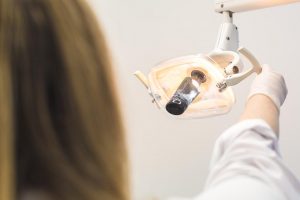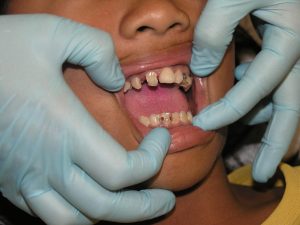
The dentist begins the procedure by preparing the tooth and necessary surrounding areas in order to restore the decay or damage. The decay or damage is removed with a dental handpiece and the area is cleansed to remove bacteria or debris before the restoration is completed.
The first step in bonding a composite filling procedure involves isolation of the tooth from saliva. Tooth isolation is critical in a composite restoration because it prevents moisture from interfering with the bonding process. This requires the placement of various adhesives followed by the composite material, which is then hardened with a special bonding light. The completed composite restoration is both functional and natural looking.
After the cavity has been filled, your dentist will discuss steps you can take to prevent decay from forming under or around the filling, or in other teeth.
If you, your family or friends need dental care, we would be honored to provide you with state-of-the-art dental care in our modern dental practice. Refer someone you love to someone you trust!
Presented as a service to the community by Doctors Hoover and Yanda,
39 Milford Drive, Hudson, Ohio 44236. 330-650-0360. www.drshooverandyanda.com

 Composite fillings are usually more expensive than traditional amalgam fillings because they require a more sophisticated process, more expensive materials and additional office equipment. Composite materials offer an aesthetic alternative to traditional amalgam materials. Because composites can be bonded to teeth, they provide a better seal against leakage and further decay. As such, people who have previously received amalgam fillings often return to their dentist to have them replaced with composite.
Composite fillings are usually more expensive than traditional amalgam fillings because they require a more sophisticated process, more expensive materials and additional office equipment. Composite materials offer an aesthetic alternative to traditional amalgam materials. Because composites can be bonded to teeth, they provide a better seal against leakage and further decay. As such, people who have previously received amalgam fillings often return to their dentist to have them replaced with composite. Composite fillings are usually more expensive than traditional amalgam fillings because they require a more sophisticated process, more expensive materials and additional office equipment. Composite materials offer an aesthetic alternative to traditional amalgam materials. Because composites can be bonded to teeth, they provide a better seal against leakage and further decay. As such, people who have previously received amalgam fillings often return to their dentist to have them replaced with composite.
Composite fillings are usually more expensive than traditional amalgam fillings because they require a more sophisticated process, more expensive materials and additional office equipment. Composite materials offer an aesthetic alternative to traditional amalgam materials. Because composites can be bonded to teeth, they provide a better seal against leakage and further decay. As such, people who have previously received amalgam fillings often return to their dentist to have them replaced with composite. One of the more common oral health issues discovered during scheduled cleanings is dental caries (tooth decay). Your dentist will examine your teeth using a dental instrument called an explorer and may also take an X-ray to determine the extent and exact location of the cavity and decay. In our office, we also use a laser to help detect decay.
One of the more common oral health issues discovered during scheduled cleanings is dental caries (tooth decay). Your dentist will examine your teeth using a dental instrument called an explorer and may also take an X-ray to determine the extent and exact location of the cavity and decay. In our office, we also use a laser to help detect decay.